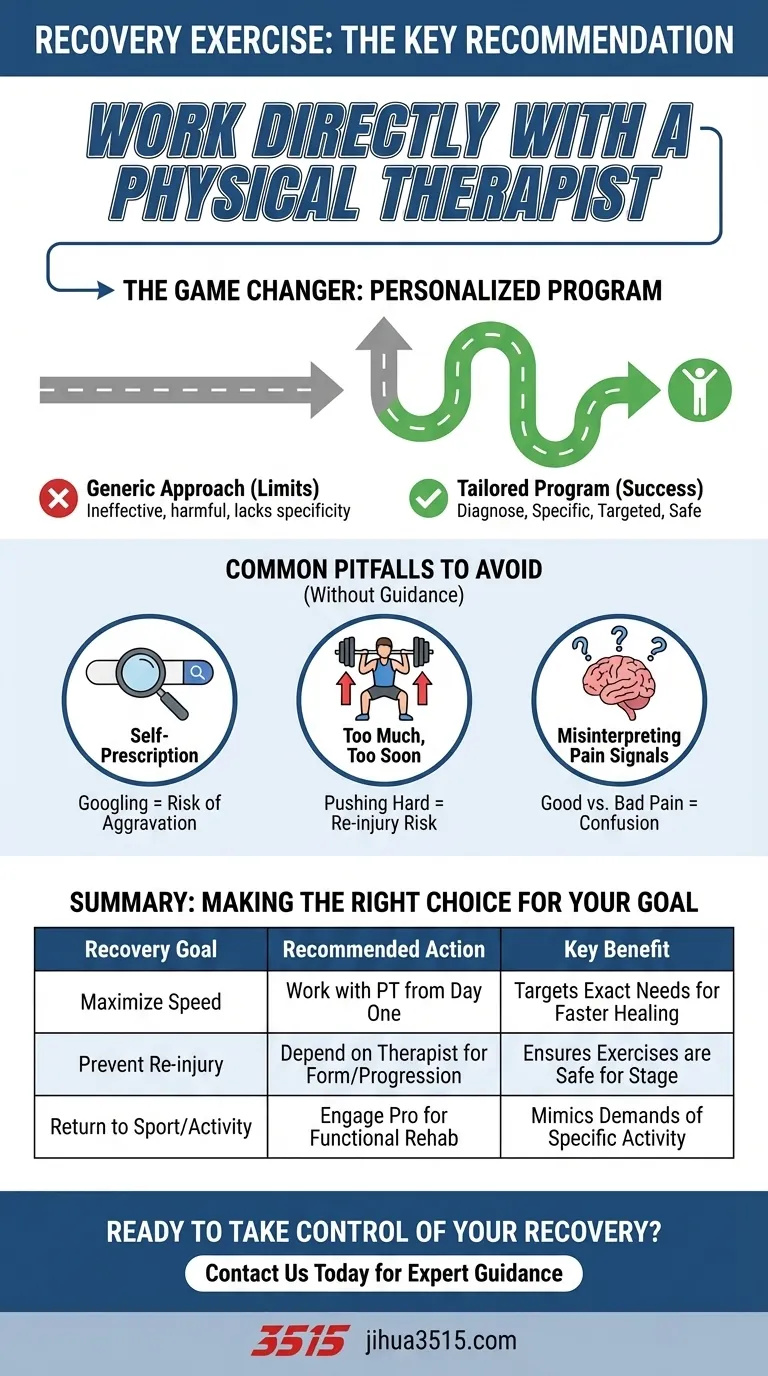The key additional recommendation for exercise during recovery is to work directly with a physical therapist. While general exercises are beneficial, a professional ensures your program is specifically tailored to your individual injury or surgery, which is critical for maximizing recovery and ensuring safety.
A generic exercise plan is a starting point, but true recovery hinges on a personalized program. Engaging a physical therapist transforms a general approach into a precise, safe, and effective strategy for healing.

Beyond General Advice: The Need for a Tailored Program
Many people understand that movement is a key part of healing. However, the type of movement is what separates a fast, successful recovery from a frustrating one fraught with setbacks.
The Limits of a Generic Approach
A one-size-fits-all exercise list found online or in a pamphlet does not account for your unique situation. It cannot assess your specific weaknesses, movement patterns, or the precise nature of your tissue damage.
This lack of specificity can lead to performing exercises that are either ineffective or, worse, actively harmful to your recovery.
The Role of the Physical Therapist
A physical therapist is a trained medical professional who specializes in biomechanics and rehabilitation. Their expertise goes far beyond simply recommending exercises.
They diagnose movement dysfunctions, understand the stages of tissue healing, and know how to apply the right stress at the right time to promote recovery without causing further damage.
How a Program is Personalized
A tailored program is designed around your specific condition. If you've had knee surgery, for example, the therapist will create exercises that strengthen supporting muscles like the quadriceps and glutes without compromising the healing joint.
This personalization ensures that every movement has a clear therapeutic purpose.
Common Pitfalls to Avoid in Recovery
Relying on self-direction during a vulnerable healing period can lead to predictable and preventable mistakes. Understanding these pitfalls highlights the value of professional guidance.
The Risk of Self-Prescription
Googling "exercises for back pain" can yield thousands of results, but it's impossible to know which ones are right for the cause of your pain. This is a significant risk that can easily aggravate an injury.
The "Too Much, Too Soon" Trap
Enthusiasm to get better can lead people to push too hard. A physical therapist acts as an objective guide, ensuring you progress at a pace your body can handle, which is crucial for preventing re-injury.
Misinterpreting Pain Signals
Distinguishing between "good pain" (muscle fatigue) and "bad pain" (joint or tissue strain) is difficult without experience. A professional helps you interpret your body's signals correctly to keep you on a safe path.
Making the Right Choice for Your Goal
To optimize your recovery, your approach should align with your primary objective.
- If your primary focus is maximizing recovery speed: Work with a physical therapist to create a highly specific plan that targets your exact needs from day one.
- If your primary focus is preventing re-injury: Depend on a therapist's expertise to ensure your form is correct and the exercises are appropriate for your stage of healing.
- If your primary focus is a safe return to a specific sport or activity: Engage a professional who can design a functional rehabilitation program that mimics the demands of that activity.
Ultimately, investing in professional guidance is the most reliable way to take control of your healing process.
Summary Table:
| Recovery Goal | Recommended Action | Key Benefit |
|---|---|---|
| Maximize Recovery Speed | Work with a physical therapist from day one | Targets your exact needs for faster healing |
| Prevent Re-injury | Depend on a therapist for correct form and progression | Ensures exercises are safe for your healing stage |
| Return to Sport/Activity | Engage a professional for functional rehabilitation | Mimics the demands of your specific activity |
Ready to take control of your recovery? Don't leave your healing to chance. A personalized exercise program designed by a professional is the most effective way to ensure a safe and speedy return to your active life. Contact us today to learn how expert guidance can transform your recovery journey and help you achieve your goals.
Visual Guide

Related Products
- Wholesale Customizable Suede Safety Boots - Puncture-Proof with Velcro Closure
- Customizable Slip-On Safety Shoes Direct from the Factory for Wholesale
- Durable Military Combat Boots with Water Drainage for Wholesale & OEM
- Safety Footwear Wholesale Manufacturer for Custom OEM/ODM Production
- Wholesale Mesh Steel Toe Safety Shoes with Dial Closure Factory Production
People Also Ask
- What regular maintenance checks should be performed on safety boots? A Daily Safety Checklist
- How does toe box design differ between men's and women's work boots? Fit for a Woman's Foot Anatomy
- What are the cultural perspectives on wearing shoes in the house? A Guide to Home Etiquette & Hygiene
- Is it normal to wear shoes in the house? A Guide to Hygiene, Comfort & Culture
- What are the potential consequences of wearing improperly designed work boots? Avoid Injury & Boost Safety






